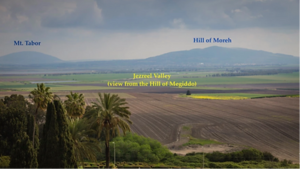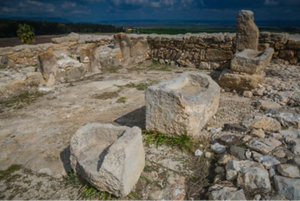A thrilling storyline with a “media” build-up pairing two formidable titans of strength and power is dramatized in the visually compelling book of Revelation. As the story unfolds, a graphic portrayal of war and the problems that ensue are revealed as 4 different horses ride across the proverbial stage of this apocalyptic drama. As the story progresses, the reader is allowed to see that a Red Dragon (Satan) and his ally (the Roman Empire) are the culprits behind the war and its bloody aftermath.
In the process of war, Christians are being killed, and the outcome looks dark and bleak. It appears that Satan may be winning the battle, but alas, riding on a white horse a champion emerges. He dons a crown and wields a sword. His eyes are like a flame of fire, and on his thigh and on his robe are written, “King of Kings, and Lord of Lords.” He meets his opponents for one final contest on a well-known field called Armageddon. He destroys the enemy and wins the war.
The ending is always the same, yet I never tire of the story. Its hopeful message stirs our hearts in the face of defeat and spurs us on to acquire a crown of our own (Revelation 2:10). The story conveys a message of victory, but so does its battlefield, Armageddon, known more accurately as the hill of Megiddo.
The word Armageddon is a Greek amalgamation of two Hebrew words, Har meaning “hill”, and the name for the biblical city known as “Megiddo”. The ruins of the ancient city lie at the base of the Carmel Mountain Range, overlooking the rich agricultural plains of the Jezreel Valley.
Located some 15 miles east of the Mediterranean Sea, Megddo was perfectly situated along an international trade route that ran from Egypt in the south to Mesopotamia in the north. The territory of Israel overall was hemmed in by the desert to the east and the Mediterranean Sea in the west, and it became a land bridge between the great empires of Egypt in the south and Mesopotamia in the north. In the most direct route from one end of Israel to the other, both trading caravans and conquering armies alike would often pass through the Jezreel Valley,f Megiddo, near the city o that guarded this all-important highway.
Because of its location, Megiddo was a commercial gold mine for trade and an important military objective for conquering nations. In the past 4000 years, no less than 34 bloody conflicts have occurred either at Megiddo or in the adjacent fertile fields of the Jezreel Valley. Biblical figures like Joshua, Solomon, Deborah, Josiah, Nebuchadnezzar, and even the 18th-century Napoleon Bonaparte all saw this area as critical to their success.

If a nation was victorious on this battlefield and gained control of Megiddo, then the spoils of war would be abundant, including the control of all that flowed along the international north-south trade route of wealth and power. To lose here was devastating and associated with death and mourning (Zechariah 12:11), but to win at this location meant triumph and control.
With each battle fought here, there was one important message: win at Megiddo and you win the war, and thereby secure a nation’s hope and promise. It should come as no surprise, then, that in the book of Revelation, this place—Har Megiddo (Armageddon)—would be used to symbolize a decisive battle and crushing defeat over Satan and his emissaries. When Christ wins the battle symbolized in Megiddo, He wins the war and secures the hope and promise reserved for His persecuted saints.
When the book of Revelation was composed, Rome had control of the “Megiddos” of the world, and at times, they were oppressive and sadistic in the exercise of that control. Christians were being persecuted, and some murdered (Revelation 2:13), but an even greater period of oppression was prophesied to occur (Revelation 2:10). As revealed in the imagery of the four horses and their riders (Revelation 6), Christians would soon feel the impact of war, bloodshed, and economic hardship.
The militarism of Rome and its trade practices, so intertwined with pagan deities and emperor cult worship associated with the mark of the beast, made it difficult in many places for Christians to maintain their livelihood (Revelation 13:17). Rome also controlled metropolitan areas, important trade routes critical for life-giving commerce, and the trade guilds. Remaining faithful to God might mean losing your job, facing ridicule, imprisonment, or even death.
Thus, in the midst of their hardship, Christians needed to be encouraged and to see things from God’s perspective. They needed to remember that while Rome was temporarily ruling on the earth, God ruled the entire cosmos. One of the main lessons from the book of Revelation is that the great Christ warrior would ultimately destroy Satan and his evil emissary, the Roman Empire.
Using awe-inspiring and highly symbolic figurative language, the book asserts the past, present, and future reign of Christ and the ultimate victory of the saints. While Satan employed the use of the Roman Empire, symbolized as the Land Beast, Sea Beast, and the Scarlet woman, the vision of Revelation demonstrated that Christ rules and that God would bring judgment upon Rome and upon any nation that would persecute Christians and likewise seek to assert its rule over the earth.
By the time readers arrive at Revelation 16, where the battle of Armageddon is foretold, the stage has been set, and the menacing allies of Satan have rebelled long enough. God had looked for repentance, but none was to be found. In His righteousness, He began to exercise judgment as witnessed in the imagery of bowls containing His vengeful wrath, poured out on those who had worshipped the beast (i.e., Rome) and persecuted the people of God (16:6). In a brief interlude between the pouring out of the sixth and seventh bowl, persecuted Christians are given another image of judgment: this time it is a scene of war between the unclean spirits of Satan’s allies and God Almighty.
With Megiddo’s monumental importance in view, imagine how knowledge of Megiddo’s strategic location would have served to encourage persecuted Christians who, in reading the book of Revelation, would have come across these verses:
“And I saw three unclean spirits like frogs coming out of the mouth of the dragon, out of the mouth of the beast, and out of the mouth of the false prophet. For they are spirits of demons, performing signs, which go out to the kings of the earth and of the whole world, to gather them to the battle of that great day of God Almighty. “Behold, I am coming as a thief. Blessed is he who watches, and keeps his garments, lest he walk naked and they see his shame.” And they gathered them together to the place called in Hebrew, Armageddon“…Rev. 16:14-16
The hill of Megiddo and its adjacent valley had long been a symbol of control and dominance and a place for heartache and failure. Later, in Revelation 19:11-21, when the symbolic battle of Armageddon is graphically dramatized, Jesus, the King of Kings and the Lord of Lords marshals His forces and annihilates the devil, asserts His dominance, and brings heartache and failure to the emissaries of evil.
 The message is clear: Rome will be conquered and judged, and Satan will not win the ultimate battle over those who belong to Christ! Just as Joshua and Deborah both defeated the Canaanites in the valley near Megiddo, so Christ would defeat Satan’s allies. Just as Gideon and Solomon won control of this place, thereby strengthening the nation of Israel, so Christians would be strengthened in their personal battles against evil.
The message is clear: Rome will be conquered and judged, and Satan will not win the ultimate battle over those who belong to Christ! Just as Joshua and Deborah both defeated the Canaanites in the valley near Megiddo, so Christ would defeat Satan’s allies. Just as Gideon and Solomon won control of this place, thereby strengthening the nation of Israel, so Christians would be strengthened in their personal battles against evil.
The Battle of Armageddon was never a literal battle to be fought in the valley near the ancient ruins of Megiddo sometime in the future, but rather it symbolized a decisive and critical battle where good wins over evil, and of Christ who ultimately brought the mighty Roman Empire to its knees.
Whether Satan’s allies are the evil empires of the past or the sin and trouble that permeate our present world, we should always remember this:
With Christ on our side, we will always be victorious!
If we belong to Christ, we will win the decisive battles of Megiddo. We cannot be defeated; if God is for us, who can be against us? The vivid imagery of Megiddo is a certain reminder that no matter what the armies of this world may accomplish, no matter how much power they might possess, no matter how deceptive and ruthless they become—in the final analysis, they will not be victorious, for God has shown us that Jesus wins the war every single time. Nowhere is that message clearer than in the symbolism of Armageddon, the hill of Megiddo, a battleground for the ages.
For further analysis and study, see the Bible Land Passage Connections video called “What Does Archaeology Reveal About Armageddon” at www.biblelandpassages.org.
By John W. Moore

